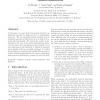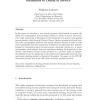IACR
2011
13 years 5 months ago
2011
In this paper we present the first public key encryption scheme that is structure preserving, i.e., our encryption scheme uses only algebraic operations. In particular it does not...
ASIACRYPT
2011
Springer
13 years 6 months ago
2011
Springer
A fundamental question in cryptography deals with understanding the role that randomness plays in cryptographic protocols and to what extent it is necessary. One particular line o...
ASIACRYPT
2010
Springer
14 years 4 months ago
2010
Springer
We design cryptographic protocols that recognize best case (optimistic) situations and exploit them. As a case study, we present a new concurrent zeroknowledge protocol that is exp...
TOCL
2008
14 years 5 months ago
2008
Cryptographic protocols with single blind copying were defined and modeled by Comon and Cortier using the new class C of first order clauses, which extends the Skolem class. They s...
TC
2008
14 years 5 months ago
2008
RFID (Radio Frequency IDentification) tags need to include security functions, yet at the same time their resources are extremely limited. Moreover, to provide privacy, authenticat...
IJNSEC
2007
14 years 5 months ago
2007
In this paper, we argue that heterogeneity should be an important principle in design and use of cryptographic protocols. We use automated formal analysis tools to randomly genera...
IANDC
2007
14 years 5 months ago
2007
Cryptographic protocols can be divided into (1) protocols where the protocol steps are simple from a computational point of view and can thus be modeled by simple means, for insta...
IANDC
2007
14 years 5 months ago
2007
We explore the notion of alternating two-way tree automata modulo the theory of finitely many associative-commutative (AC) symbols. This was prompted by questions arising in cryp...
JCS
2006
14 years 6 months ago
2006
Abstract: Cryptographic protocols are successfully analyzed using formal methods. However, formal approaches usually consider the encryption schemes as black boxes and assume that ...
CN
2006
14 years 6 months ago
2006
In this paper, we introduce a new security property which intends to capture the ability of a cryptographic protocol being resistant to denial of service. This property, called im...


